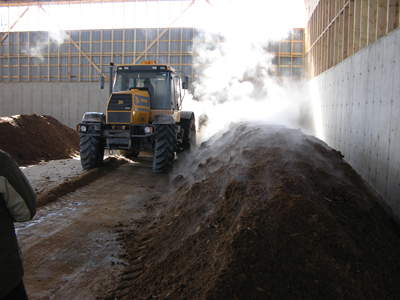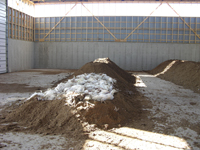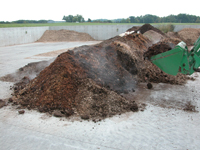
Features
Applications
Poultry
Life after Death
June 28, 2010 by By the Ontario Livestock and Poultry Council
With changes to deadstock removal requirements and loss of rendering
facilities, farmers are looking at on-farm disposal options.
With changes to deadstock removal requirements and loss of rendering facilities, farmers are looking at on-farm disposal options. Two Iowa on-farm poultry research and demonstration projects have shown composting to be simpler than burial. Additionally, excessive nitrogen buildup can be a problem at burial sites, whereas composting produces a humus-like product containing nutrients and organic matter that can be recycled onto cropland. Composting carcasses is also a good biosecurity measure because most disease organisms can be killed by exposure to the temperature levels in a compost pile or bin (58 to 68 C/135 to 155 F). As well, it is preferable to keep any disease organism on-farm rather than risk transmitting it during removal and transportion of deadstock.

|
|
| Aerobic composting is best, as the byproducts are simply water, carbon dioxide and heat. A front end loader can be used to periodically turn the compost, as long as you ensure the animals are covered by at least 60 centimeters of compost when you’re done.
|
Deadstock composting can be done in windrows, in a bin system, or in sealed containers. For in-vessel composting, the composting mixture must be 50 percent dead farm animals and 50 percent substrate. For other methods, the mixture should be no more than 25 percent dead farm animals and 75 percent co-composting material.
The right conditions
There are five key factors to successful composting: moisture, composting materials, carbon and nitrogen balance, oxygen, and heat retention.
- Moisture: A very important factor in composting deadstock is the moisture content of the compost mix. Too little moisture promotes dehydration, which preserves tissues, while too much moisture leads to foul odors and leaching. The moisture content of the compost mix should be 40 percent to 50 percent; a squeezed handful should leave moisture on the palm of your hand without forming drops. A mix that is too dry or too wet will not develop the desired temperature to effectively compost. Large animals can add considerable moisture and the starting compost mix can be slightly dry. Small animals loaded a few at a time will add little water so you may need to add water.
- Materials: The following readily available materials can be used as composting material:
- Clean, untreated and uncontaminated wood sawdust, shavings or chips.
- Straw consisting of dried grain, corn or bean stalks and leaves.
- Clean hay or silage.
- A mixture composed of livestock manure and bedding material (as listed above). The mixture must be at least 30 percent dry matter by weight.
- Poultry litter (a mixture of wood shavings and poultry manure). Sawdust is particularly good for absorbing excess liquid whereas coarse material like ground corncobs or wood chips helps keep the compost porous and allows oxygen into the pile and gases like ammonia to escape. Poultry litter is the most common compost material for turkey and broiler carcasses.
- C:N balance: Without a proper balance of carbon and nitrogen, microbial growth is slowed and the rate of decay is reduced. Temperature and odor can be used as general indicators of the C:N balance. If ammonia odors become a problem, adding a high-carbon compost material such as sawdust can raise the C:N ratio. If moisture levels appear to be within the recommended range, strong ammonia odors are not present, and decay is still slow, insufficient nitrogen may be the cause. Additional nitrogen in the form of manure can be added to lower the C:N ratio and boost the rate of decay.
Animals weighing less than 300 pounds (136 kilograms) can be composted whole, but larger animal carcasses should be opened or split. Start with a base layer of compost material at least one foot (30 centimeters) thick to act as a sponge. Animals can be loaded in layers and covered with the compost mix. Small animals can be placed side by side in layers no more than eight inches (20 centimeters) thick with compost mix between and around the layers. Water may be added as the layers are being constructed if required. At each loading, make sure that the top animal is covered with at least two feet (60 centimeters) of compost mix. - Oxygen: Aerobic composting (oxygen-using) is more desirable than anaerobic decomposition because the major byproducts are water, carbon dioxide and heat. Anaerobic decomposition, by contrast, produces little heat and generates unpleasant odors such as hydrogen sulfide and organic acids. Avoiding overly wet compost, periodically turning the compost with a loader, and using relatively coarse composting materials that allow oxygen into the pile can help avoid odor problems. If you aerate the compost pile, ensure that any exposed animal parts are fully covered with at least two feet (60 centimeters) of compost mix.
- Heat retention: The compost pile should reach internal temperatures of 135 to 155 F (58 to 68 C). This temperature range encourages the rapid growth of heat-loving bacteria that promote decay. As an added benefit, exposure to high temperatures helps to kill disease-causing organisms.
When you’re done
Composting is considered complete when there is:
- no soft animal tissue at all;
- no bones or bone fragments larger than six inches (15 centimeters);
- no other animal matter larger than one inch (2.5 centimeters); and,
- no offensive odors.
 |

|
| Small animals can be placed side by side in layers no more than 20 centimeters (eight inches) thick with compost mix between and around the layers.
|
The right mix of compost material is crucial to create the right environment for effective decomposition. Moisture and the right carbon:nitrogen balance are key.
|
When the compost material meets these requirements, it may be applied to farmland where the composting activity occurred.
On-farm composting of dead animals is regulated under the Nutrient Management Act, 2002 (NMA). This regulation applies to all farm operations, regardless of the requirement to have a nutrient management strategy or plan and sets out minimum distances for composting piles from lot lines, water courses, tile drains, etc. It is recommended you review these criteria prior to establishing your deadstock composting site.
Further details on composting bin design, deadstock handling and regulatory requirements may be found on the Ontario Ministry of Agriculture, Food and Rural Affairs website at http://www.omafra.gov.on.ca/english/livestock/deadstock/index
This article was provided by the Ontario Livestock and Poultry Council. The Council provides a forum to facilitate the development and coordination of an Ontario strategy to deal with foreign animal disease and other transmissible livestock and poultry diseases.
References
Composting Animal Mortalities on the Farm, Maryland Cooperative Extension, University of Maryland.
Composting dead livestock: A new solution to an old problem, Leopold Center, Iowa State University Extension.
Disposal of Dead Farm Animals, Ontario Regulation 106/09, Nutrient Management Act, 2002.
| Alberta continues liquid manure application pilot The province of Alberta is working to increase the adoption of injecting and/or surface-banding liquid manure by dairy operations in Alberta. A four-year pilot initiative was launched in the fall of 2008, aimed at increasing the use of the technologies. The joint project involves Alberta Agriculture and Rural Development, Red Deer County, Leduc County, the County of Wetaskiwin, and Alberta Milk – is adoption of liquid manure injection or surface-banding application technology. “The main reasons for moving from broadcast liquid manure application to injection or surface-banding are to reduce the amount of nitrogen lost from the manure being applied and to reduce odor from liquid manure application,” says Stephanie Kosinski, a forage specialist with Alberta Agriculture and Rural Development. “Initial 2009 plot data analysis showed that injecting liquid dairy manure at a rate of 6000 gallons/acre increased barley yield from 3.1 to 5.01 tons/acre (dry weight) compared to broadcasting and incorporation. This translated into a net economic benefit of injection of $45.85/acre, based on an assumed market value of silage at $35/ton in the pit and a cost premium for injection of $0.0035/gallon.” Based on results from a 2009 survey, the average Alberta herd size is 119 head of milking and dry cows, and 52 percent of producers managed between 160 and 640 acres, with the largest operations topping out at more than 1200 acres. Of the land being managed by dairies, most is seeded to annuals, with less than half being used as hay and pasture. In order to increase knowledge and awareness about manure application techniques, three or four small-plot demonstration sites were established this spring. These are in addition to three sites set-up last year. These sites will highlight the use of different injection equipment. The co-operating producers will seed annual crops across these sites, and yield data will be collected. Further economic analyses will be conducted to highlight the benefits of injection in terms of yield and nutrient capture. Field days at each of the demonstration sites will be held to allow dairy producers to see the impact injecting manure can have. |